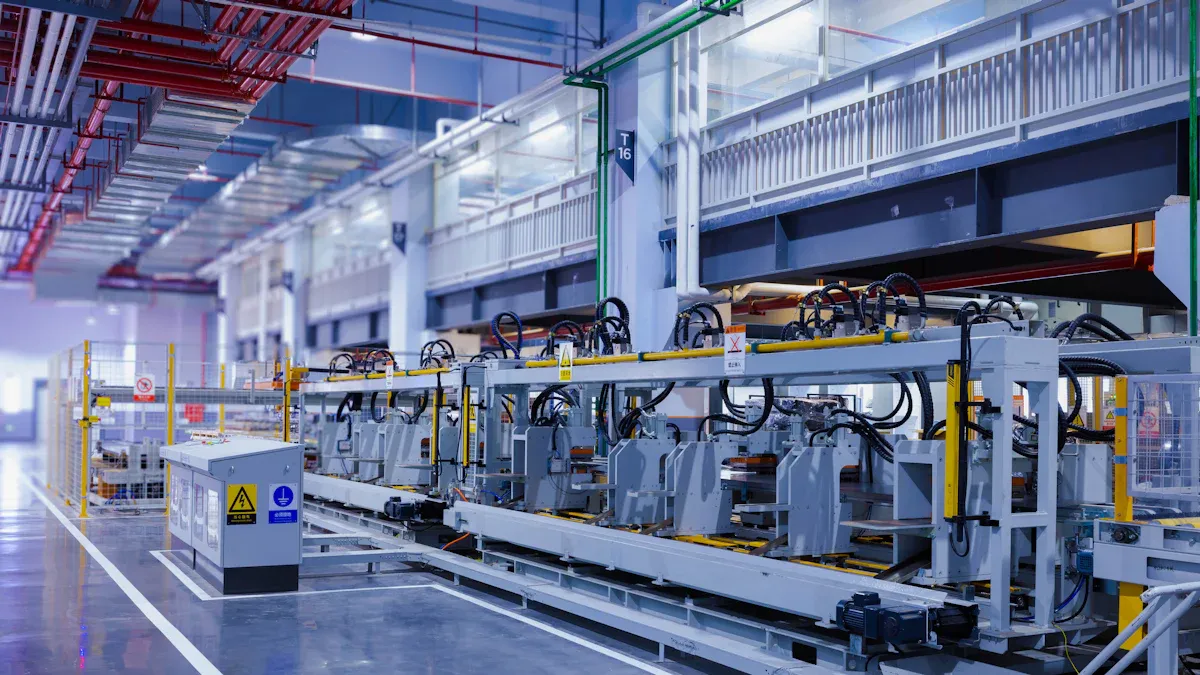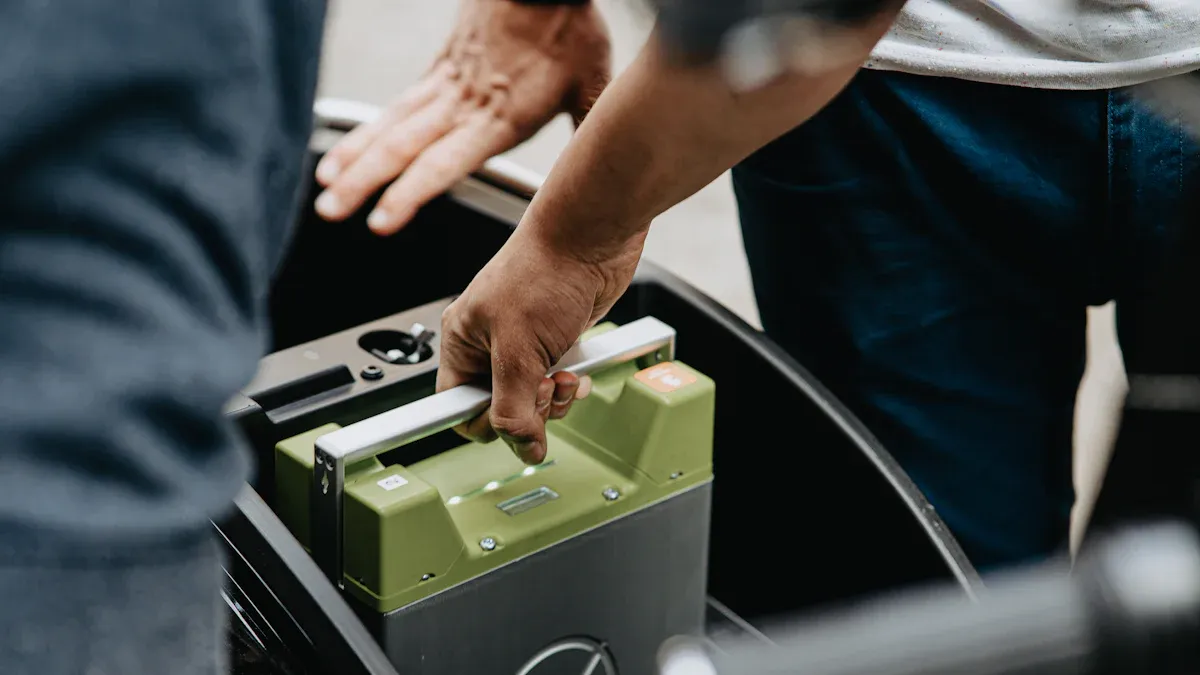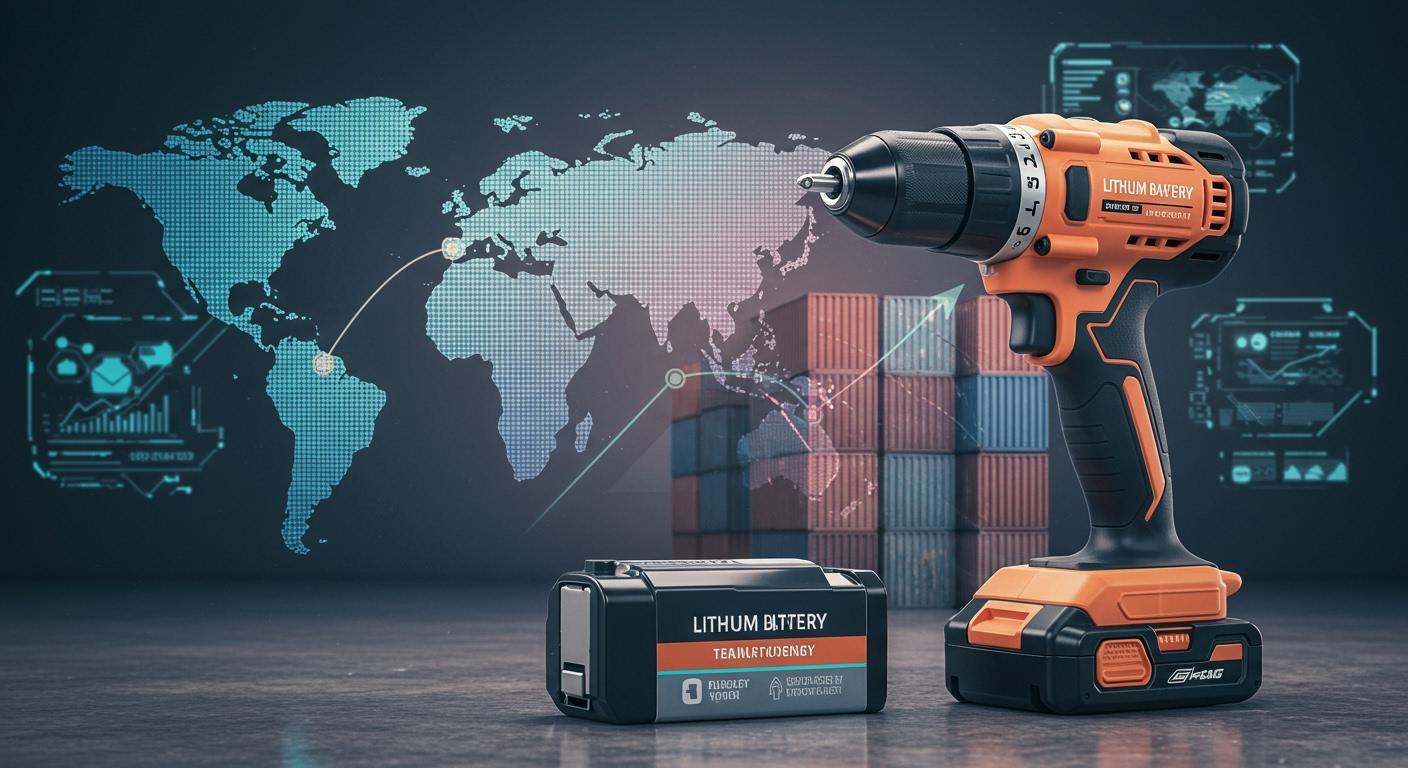Lithium battery opportunities reshape global power tool shipments in 2025
You see a major shift in global power tool shipments as lithium battery technology advances. The market size for global power tools grew from $41.51 billion in 2024 to $43.65 billion in 2025, showing strong battery demand and a 5.1% growth rate. Manufacturers now use automated lithium battery assembly lines, while AI-driven demand forecast tools help suppliers deliver faster. End-users enjoy better tool performance and smart lithium features.
The table below shows top market drivers for battery-powered tools:
| Market Driver | Description |
|---|---|
| Advancements in Battery Technology | Lithium-ion batteries offer higher capacity, longer lifespan, and faster charging. |
| Growing Demand for Portable Tools | Portability and user-friendliness boost demand on job sites. |
| Environmental Concerns | Battery-powered tools reduce reliance on energy production from non-renewable sources. |
| Ergonomic and User-Friendly Features | Customizable settings and performance enhance user experience. |
| Rise of DIY Culture | Affordable lithium battery tools and DIY platforms spark new demand. |
| Customization Options | Interchangeable accessories and speed controls attract a wide range of users. |
Key Takeaways
- Lithium battery technology drives a significant increase in global power tool shipments, projected to grow from $41.51 billion in 2024 to $43.65 billion in 2025.
- Asia-Pacific leads the market growth due to rapid industrialization and urbanization, with a focus on battery-powered tools for efficiency and flexibility.
- Advancements in lithium battery technology, such as solid-state and quick-charging batteries, enhance tool performance and reduce downtime for users.
- Sustainable practices in battery production and recycling are becoming essential, helping to minimize environmental impact and promote responsible sourcing.
- The rise of AI and smart features in power tools improves user experience, making tools more efficient and easier to use.
Global power tool shipments

Shipment trends 2025
You see global power tool shipments reaching new heights in 2025. The market continues to expand, with global power tools valued at $41.51 billion in 2024 and projected to hit $43.65 billion in 2025. This steady rise shows a 5.1% growth rate, which signals strong global shipment growth. You notice that battery-powered tools now drive much of this increase. Battery sales have surged as users seek cordless convenience and longer runtimes. Manufacturers respond by launching new models with advanced battery technology, which boosts both shipment volumes and user satisfaction.
You can track the shift in shipment trends by looking at the growing share of battery-powered tools. These tools now make up a larger portion of global power tool shipments than ever before. The demand for efficient, portable solutions pushes companies to innovate and deliver products that meet your needs. As a result, battery sales continue to climb, and you benefit from a wider selection of high-performance tools.
Regional growth
When you examine regional trends, Asia-Pacific stands out as the fastest-growing region for global power tool shipments. The table below highlights the growth rates and key notes for major regions:
| Region | Growth Rate | Notes |
|---|---|---|
| Asia-Pacific | Fastest | Largest region in power tools market 2024 |
| Asia-Pacific | 4.7% CAGR | Driven by expanding industrial activities |
| Asia-Pacific | Higher CAGR | Expected to grow throughout the forecast period |
You see that Asia-Pacific leads global shipment growth, fueled by rapid industrialization and a booming construction sector. Countries like China and India invest heavily in infrastructure and urbanization, which increases demand for power tools. The market in this region also shifts as more users choose to rent equipment instead of buying, which changes how companies approach sales and distribution.
- The Asia-Pacific markets experience rapid industrialization and strong construction activity.
- China and India drive demand through large infrastructure projects and urban growth.
- The trend toward renting power tools transforms the market and creates new opportunities.
- Both professionals and DIY users contribute to rising demand in the region.
- The cordless power tools market in Asia-Pacific is set to exceed US$ 7.67 billion by 2031, with China holding a significant share.
- Automotive and construction sectors play a major role in boosting demand for cordless tools.
You notice that battery-powered tools are especially popular in Asia-Pacific. The region’s focus on efficiency and flexibility makes battery technology a top priority. As a result, global power tool shipments from this area continue to rise, and you see more innovative products entering the market. This regional growth shapes the future of the industry and sets new standards for performance and convenience.
Lithium battery market impact

Technology trends
You see lithium battery technology changing the way you use power tools. New battery packs from brands like Milwaukee, DeWalt, and Bosch show major improvements. These batteries deliver consistent power, so your tools work at full strength until the charge runs out. You notice that solid-state batteries are being developed, which could replace current lithium batteries in the future. Researchers are working on self-healing batteries to make lithium cells last longer. Nano-sized lithium-ion batteries are also being created, making it possible to build smaller and more efficient tools.
- Solid-state batteries promise safer and longer-lasting performance.
- Self-healing batteries could reduce the need for frequent replacements.
- Nano-sized batteries open new possibilities for miniaturized electronics.
Lithium battery advancements give you reliable power and longer tool life. You benefit from tools that run smoothly and stay strong throughout the job. These technology trends push manufacturers to create smarter, more efficient products.
Market opportunities
You see the lithium battery market for power tools growing quickly. The table below shows the market size and growth rate:
| Year | Market Size (USD Billion) | CAGR (%) |
|---|---|---|
| 2024 | 9.1 | 10.2 |
| 2030 | 16.1 |
Global lithium battery demand continues to rise as more users switch to cordless tools. Battery sales increase because you want lightweight, portable solutions. The market responds with new product categories that use advanced lithium battery technology. You find tools that last longer and charge faster, making your work easier.
You notice a strong demand for quick-charging batteries. The 3C-rate segment grows fast in the market. These batteries work well in cordless saws and drills. High power output and rapid charging help you reduce downtime and boost efficiency.
- Quick-charging batteries let you get back to work faster.
- High output batteries improve tool performance.
- Fast charge technology supports longer work sessions.
Battery demand drives innovation in new cordless tool categories. You see more efficient and eco-friendly tools on the market. Lithium battery technology leads to products that meet your needs, whether you are a professional or a DIY user. Battery sales reflect this shift, with global battery sales reaching new highs.
The growth of the cordless power tool market comes from better battery technology and rising demand for flexible solutions. You benefit from tools that are lighter, safer, and more powerful. Manufacturers respond by offering new types of cordless tools that use lithium batteries. These innovations create new opportunities for you and change the way you work.
Manufacturers and supply chains
Production shifts
You see manufacturers changing how they build power tools to meet the rising demand for lithium battery technology. Many companies now use lithium-ion batteries to power their tools and equipment. These batteries help you work faster and reduce downtime, which boosts productivity. You also notice that manufacturers focus on more sustainable practices by using lithium batteries.
Manufacturers use digital tools to improve how they make batteries. They often start with small pilot projects to test new technology. This approach helps teams learn new processes before using them across the whole company. You benefit from these changes because they lead to better, more reliable tools.
- Lithium-ion batteries power modern tools and increase productivity.
- Companies use digital strategies to improve battery production.
- Pilot projects help teams adapt to new lithium battery technology.
- Sustainable manufacturing grows as more companies use lithium batteries.
You see that these shifts make tools more efficient and help manufacturers keep up with the fast-changing market.
Supply chain changes
You face new challenges as companies work to secure a steady supply of lithium batteries. Many manufacturers look for new ways to source materials and build stronger supply chains. The table below shows some of the main strategies:
| Strategy | Description |
|---|---|
| Expanding Material Alternatives | Companies research new materials to reduce reliance on cobalt and nickel. They also develop solid-state batteries and recycling methods. |
| Strengthening Regional Supply Chains | Building local supply chains helps reduce import delays and keeps battery supply stable. |
| Strategic Partnerships | Manufacturers work with governments and other businesses to share resources and invest in local infrastructure. |
You notice that most lithium battery cell production happens in China. China, Japan, and South Korea make almost all the cathode materials for batteries. Lithium mining is also concentrated in a few countries, with China, Australia, and Chile leading the way. This concentration can cause supply problems if there are disruptions.
To keep batteries safe during shipping and storage, companies follow strict rules. They train warehouse staff to handle lithium batteries safely and store them in special areas. Companies also do risk assessments to spot dangers and prepare for emergencies.
Proper training and careful storage keep lithium batteries safe and ready for use.
These changes help you get reliable, high-quality tools while keeping safety a top priority.
Market dynamics
Competitive landscape
You see the power tool industry changing fast as lithium battery technology takes center stage. Major brands compete for your attention by offering smarter, safer, and more durable tools. Companies like Panasonic, Samsung SDI, LG Chem, and Bosch invest in advanced battery technologies and strong research and development. They work with power tool manufacturers to create products that last longer and charge faster.
| Key Players | Strategies |
|---|---|
| Panasonic Corporation | Advanced battery tech, strong brand, ongoing R&D |
| Samsung SDI | Partnerships with tool makers, focus on innovation |
| LG Chem | Wide distribution, better battery safety and performance |
| Sony Corporation | Mergers and acquisitions to grow market share |
| BYD Company Ltd. | Specialized batteries for niche uses, next-gen battery focus |
| A123 Systems LLC | Higher energy density, faster charging |
| Saft Groupe S.A. | Improved safety, expansion in Asia-Pacific |
You notice that cordless tools now lead the market, especially those with lithium-ion batteries. Bosch and Milwaukee stand out for their innovation. North America remains the largest market, driven by construction and a strong DIY culture. Asia-Pacific grows the fastest, thanks to urbanization and industrial growth in China and India. Europe focuses on sustainability and smart features, with steady growth each year.
Smart features, ergonomic designs, and safety improvements shape the tools you use every day.
Manufacturers race to add smart controls, better dust extraction, and longer-lasting batteries. You benefit from tools that are easier to use and safer on the job.
New entrants
You see new companies entering the power tool market, especially in regions with rapid growth. Many startups focus on lithium battery innovation and smart technology. These new players often target niche markets or offer specialized solutions. In Asia-Pacific, a strong manufacturing base in China helps local brands grow quickly. North America attracts new brands that cater to DIY users and construction professionals who want cordless convenience. Europe encourages eco-friendly startups with government incentives.
| Region | Key Growth Factors |
|---|---|
| Asia-Pacific | Large production and consumption, strong manufacturing in China |
| North America | High demand from construction and DIY, preference for cordless tools |
| Europe | Growth from environmental awareness, support for green technologies |
You see more choices and better prices as competition increases. New entrants push established brands to keep innovating. This benefits you with more advanced, efficient, and sustainable power tools.
Batteries and end-users
Performance benefits
You experience many advantages when you use lithium battery-powered tools. These tools give you more freedom and flexibility because you do not need cords or fuel. You can work anywhere, which boosts your productivity. Modern batteries last longer, so you can finish a full day’s work without stopping for frequent recharging. Swappable batteries let you keep working by quickly changing out a depleted battery for a charged one. You also notice that battery-powered tools need less maintenance, which means less downtime and more time getting things done.
Here is a table showing how lithium battery-powered tools compare to traditional models:
| Performance Benefit | Description |
|---|---|
| Environmental Impact | Lithium-ion batteries produce fewer toxic materials and last longer, reducing waste. |
| Mobility | Battery tools offer freedom of movement without cords or fuel, enhancing productivity. |
| Battery Run Time | Modern battery tools provide significantly longer run times, allowing for a full day's work. |
You also benefit from improved energy efficiency and greater reliability. AI-driven features in some tools help you work smarter and faster. Lower environmental impact makes these tools a better choice for you and the planet.
Pricing trends
When you look at battery costs, you see that lithium battery-powered tools often have a higher initial price than corded models. Corded tools usually cost 30-50% less and do not require battery replacements. However, cordless tools start at $147, and you may need to spend $49 to $100 on new batteries every two to three years. If you use your tools often, the value becomes clear. You save time with better efficiency and mobility, which can offset the higher battery costs over time.
| Tool Type | Initial Cost Range | Additional Costs | Overall Value Proposition |
|---|---|---|---|
| Corded Tools | 30-50% cheaper | None (no battery replacements) | Best for workshops and occasional use |
| Cordless Tools | At least $147 | $49 to $100 every 2-3 years | Higher efficiency and mobility, worth the cost if used often |
You get longer runtimes and faster charging with lithium battery tools. User-friendly features make your work easier and more efficient. The value for you grows as you use these tools more frequently.
Sustainability
Lithium battery-powered tools support your efforts to protect the environment. Manufacturers focus on responsible production, using ethical sourcing and fair labor practices. Improved battery recycling reduces waste and keeps hazardous materials out of landfills. Sustainable mining practices help protect natural habitats during lithium extraction. Efficient waste management ensures proper storage and recycling of batteries, lowering the environmental impact.
| Sustainability Practice | Description |
|---|---|
| Responsible production | Emphasizes ethical sourcing and fair labor practices to ensure social sustainability. |
| Improved battery recycling | Reduces waste and prevents hazardous materials from polluting the environment. |
| Sustainable mining practices | Aims to minimize ecological damage and protect natural habitats during resource extraction. |
| Efficient waste management | Establishes systems for proper disposal and recycling of batteries to reduce environmental impact. |
You also see new industry standards, such as IEC 63370 and UL 2595, which ensure safety for lithium battery storage and charging. These standards help keep you safe while supporting a cleaner future. As you choose lithium battery-powered tools, you support portable energy storage solutions that are better for both you and the environment.
You see lithium battery opportunities reshaping global power tool shipments in 2025. The table below highlights how AI integration, fast-charging tech, and sustainability focus transform the industry:
| Transformative Impact | Description |
|---|---|
| AI Integration | AI optimizes design and manufacturing, enhancing battery performance and longevity. |
| Fast-Charging Tech | Advances in fast-charging allow for increased productivity without performance loss. |
| Sustainability Focus | Development of eco-friendly, recyclable batteries reduces environmental impact. |
Manufacturers, suppliers, and end-users can adapt by focusing on sustainability, adopting modular battery designs, and using digital sales channels. You will notice lithium batteries becoming central to tool intelligence and performance. Future trends include robotics, augmented reality, and climate-resilient solutions. You benefit from choosing battery brands that align with technological advancements.
-

 May.2025.11.24Ternary Lithium Battery vs Lithium-ion: Complete Comparison Guide (2025 Edition)Learn More
May.2025.11.24Ternary Lithium Battery vs Lithium-ion: Complete Comparison Guide (2025 Edition)Learn More -

 May.2025.11.214S2P 18650 14.8V Battery: Complete Technical Guide, Specs, Applications & SafetyLearn More
May.2025.11.214S2P 18650 14.8V Battery: Complete Technical Guide, Specs, Applications & SafetyLearn More -

 May.2025.11.18PCM vs BMS in Lithium Batteries: What’s the Difference and Which One Do You Need?Learn More
May.2025.11.18PCM vs BMS in Lithium Batteries: What’s the Difference and Which One Do You Need?Learn More -

 May.2025.11.17Custom Li-ion Battery Design for Medical Devices (2025 Comprehensive Guide)Learn More
May.2025.11.17Custom Li-ion Battery Design for Medical Devices (2025 Comprehensive Guide)Learn More -

 May.2025.11.17The Future of Lithium-Ion Batteries: Innovation, Sustainability, and Global Market TrendsLearn More
May.2025.11.17The Future of Lithium-Ion Batteries: Innovation, Sustainability, and Global Market TrendsLearn More
















